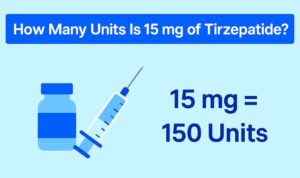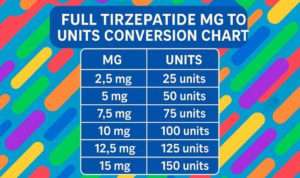
Confused about how many units is 15 mg of Tirzepatide? You’re not alone. Whether you’re managing diabetes or using it for weight loss, converting milligrams to insulin syringe units can feel tricky. But it doesn’t have to be. For a detailed step-by-step breakdown and important tips, check out our Tirzepatide Dosage & Unit Conversion Guide. Learn the exact unit count, avoid dosing mistakes, and get confident with your injections. Let’s simplify Tirzepatide together, starting with that 15 mg dose.
Why you need to convert MG to Units properly
Are you Taking Tirzepatide? Then, you must know how to convert mg to units the right way. It’s not optional. Injecting the wrong amount can lead to side effects, wasted doses, or poor results. Knowing your exact unit count matters, especially if you’re using a compounded version. Accuracy here keeps your treatment on track—whether it’s for blood sugar or weight loss. Let’s make sure your 15 mg dose is measured safely every single time.
What happens if you inject the wrong amount?
Getting the dose wrong with Tirzepatide can seriously affect your health. Injecting too much might cause nausea, dizziness, or dangerously low blood sugar. Too little? You may not see results—and waste money on your treatment. Many patients mix up mL, units, and mg, especially with U-100 syringes. One small mistake can lead to big problems. That’s why understanding exactly how many units is 15 mg of Tirzepatide is key to staying safe and seeing real progress.
How many Units is 15 mg of Tirzepatide?
If you’re holding a syringe and wondering how many units equal 15 mg of Tirzepatide, you’re not alone. This is one of the most common questions patients ask. The answer depends on the strength of your solution. The most compounded Tirzepatide is 10 mg per mL. At this concentration, 15 mg equals 1.5 mL, which is 150 units when using a U-100 insulin syringe. Always verify the vial strength before converting and injecting.
Simple formula: 15 mg = 150 Units (At 10 mg/mL)
Here’s how it works: If your Tirzepatide concentration is 10 mg/mL, then 1 mL equals 10 mg. To obtain 15 mg, you will need 1.5 mL.
If you’re using a U-100 insulin syringe, which measures in units, remember that 1 mL equals 100 units. Therefore, 1.5 mL is equivalent to 150 units.
In summary, 15 mg of Tirzepatide is equal to 150 units. Always double-check the concentration on your vial before injecting, and follow your healthcare provider’s guidance.
Full Tirzepatide MG to Units conversion chart
Are you confused about other dosages, too? This chart will help you convert different mg values of Tirzepatide into units using a 10 mg/mL concentration. Keep this as your quick reference guide.

When is 15 mg prescribed?
The 15 mg dose of Tirzepatide is usually prescribed after a patient has successfully tolerated the lower doses, such as 2.5 mg, 5 mg, 7.5 mg, 10 mg, and 12.5 mg. Doctors don’t jump to this dose immediately—it’s typically used after weeks of gradual titration. By the time someone reaches 15 mg, their body is expected to be adjusted to the medication. This dose is often chosen when lower doses aren’t giving strong enough results in blood sugar control or weight loss.
The typical titration path to 15 mg
Most patients don’t start directly with 15 mg. Doctors increase the dose step-by-step to help your body adjust safely and avoid major side effects.
- Start with 2.5 mg for 4 weeks
- Then move to a 5 mg weekly dose
- Increase to 7.5 mg after 1 month
- Step up to 10 mg once tolerated
- Some reach 12.5 mg before 15 mg
- 15 mg is the highest regular dose
Always follow your doctor’s timing—don’t rush into 15 mg without proper titration and monitoring.
Real patient experiences with the 15 mg dose.
Many patients say 15 mg gave them the best results. They noticed better blood sugar control and faster weight loss than with lower doses. Some felt more energy and less hunger.
But not everyone had a smooth time. A few reported nausea or stomach issues at first, but most improved over time. People also say it’s important to follow the dose schedule slowly. Listening to your doctor makes the experience better and safer.
Most common mistakes while measuring Tirzepatide units.
Many patients get confused when converting milligrams to units. Small dosing errors can lead to big problems. It’s important to understand your syringe, concentration, and how to measure your dose correctly every time.
- Using the wrong syringe type for Tirzepatide dosing
- Mixing up mL and Units during measurement
- Assuming all concentrations are the same, always
- Forgetting that 1 mL equals 100 units (U-100)
- Drawing too fast and getting air bubbles inside
- Not checking the mg/mL ratio on the vial
- Guessing the dose instead of using a chart
Double-checking your dose and using a chart or syringe guide can help you avoid mistakes and use Tirzepatide safely every time.
Confusing mL, Units, and MG – know the difference
Many people confuse milligrams (mg), milliliters (mL), and units when measuring Tirzepatide. But these terms are not the same. MG is the strength of the drug, mL is the liquid volume, and Units depend on the syringe type.
For example, if your Tirzepatide concentration is 10 mg per 1 mL, then 15 mg equals 1.5 mL or 150 units (using a U-100 insulin syringe). Always check your vial label and syringe type. Misreading these numbers can lead to underdosing or overdosing. When unsure, ask your doctor or use a dosage chart for safe measurement.
What to do if you miss or overdose your 15 mg Tirzepatide
If you miss a dose, take it as soon as possible, within 4 days. If it’s been more than 4 days, skip it and take the next dose as scheduled. Never double your dose to make up for a missed one. If you accidentally overdose, contact your doctor or go to the ER immediately. Overdosing can lead to nausea, vomiting, or serious side effects, so don’t guess—always follow instructions.
Tips for drawing exactly 150 Units in one injection
It’s important to measure your 15 mg dose correctly. If your vial is 10 mg/mL, 15 mg equals 150 units. Use a U-100 syringe for proper measurement.
- Use a clear U-100 insulin syringe only
- Pull the plunger slowly to avoid air bubbles
- Match 150 units mark exactly on the barrel
- Keep the syringe straight while drawing the dose
- Double-check your dose before injecting it
- Don’t reuse syringes to prevent contamination
Small mistakes in measuring can lead to big problems, so take your time, stay focused, and always follow medical instructions carefully.
Will 15 mg of Tirzepatide work for weight loss too?
Yes, many people lose weight on the 15 mg dose. It helps reduce hunger and makes you feel full longer. People say they eat less without trying. Some lose 20–25 pounds or more over time. However, the results are not the same for everyone. It works best with a healthy diet and regular movement. Always follow your doctor’s advice. Never use it for weight loss without medical guidance. Safety should always come first.
Can you split 15 mg of Tirzepatide into two doses?
No, you should not split your 15 mg dose into two smaller shots unless your doctor tells you to. Tirzepatide is designed to be taken once a week as a full dose. Splitting it can reduce how well it works or cause side effects: the timing and full delivery matter. Even if you feel the full dose is “too much,” don’t split it without medical guidance. Always talk to your doctor first before making any changes.
What experts say about dose splitting and safety
Experts clearly advise against splitting weekly Tirzepatide doses. The drug is made to release slowly over time. If you split it, you may break that timing and reduce its effect. It could also lead to uneven results or increased side effects. Doctors say one full dose once a week gives the best outcome. If you’re having trouble with side effects at 15 mg, your doctor may lower the dose or slow the titration. Don’t adjust on your own.
How long does 15 mg stay in your system?
Tirzepatide stays in your body for about 5 to 7 days after each injection. That’s why it’s taken once a week. Even if you miss a day, it may still be working. But the effects slowly fade after a week. Everyone’s body is different so that the timing can vary a little. If you stop taking it, the drug will fully leave your system in a few weeks. Always follow your schedule and talk to your doctor if you miss a dose.
FAQ
Can I take 15 mg as my starting dose?
Ans: No, most people start at 2.5 mg. Doctors increase the dose slowly to avoid strong side effects.
How many mL is 15 mg of Tirzepatide?
Ans: If your vial says 10 mg/mL, then 15 mg equals 1.5 mL. Always confirm your vial concentration.
What if I inject more than 150 units?
Ans: Overdosing can cause nausea, vomiting, or serious side effects. Call your doctor or visit the ER immediately.
Does 150 units mean 1.5 mL always?
Ans: Only if you’re using U-100 insulin syringes and the vial concentration is 10 mg/mL. Double-check before injecting.
Can I reuse the same syringe next time?
Ans: No, never reuse syringes. It increases infection risk and may affect dose accuracy. Use a new one each time.
Conclusion
Understanding how many units is 15 mg of Tirzepatide is key to using it safely and effectively. Most often, 15 mg equals 150 units if your vial is 10 mg/mL. Always double-check your syringe and vial details before injecting. A small mistake can lead to big health issues. Talk to your doctor if you’re unsure. Stay safe, follow your dosing schedule, and never guess when it comes to your medication.
Sources:
- FDA – Tirzepatide Storage & Label Information (PDF)
- Mayo Clinic – Proper Use & Dosage of Tirzepatide
- Mounjaro® – Clinical Prescribing & Dosing Guide
Medical Disclaimer:
This article is for informational purposes only and is not a substitute for professional medical advice. Always consult your doctor before starting any medication.
Reviewed & compiled by: CMH Health Editorial Team
Hello everyone, I’m Mehedi Hasan — a passionate health content creator and the founder of CMH Healths. Since 2015, I have been researching and writing about health topics with the goal of helping people live healthier and more informed lives. I focus on creating practical, research-based content on health and medicine that empowers readers to make confident, evidence-backed decisions.
